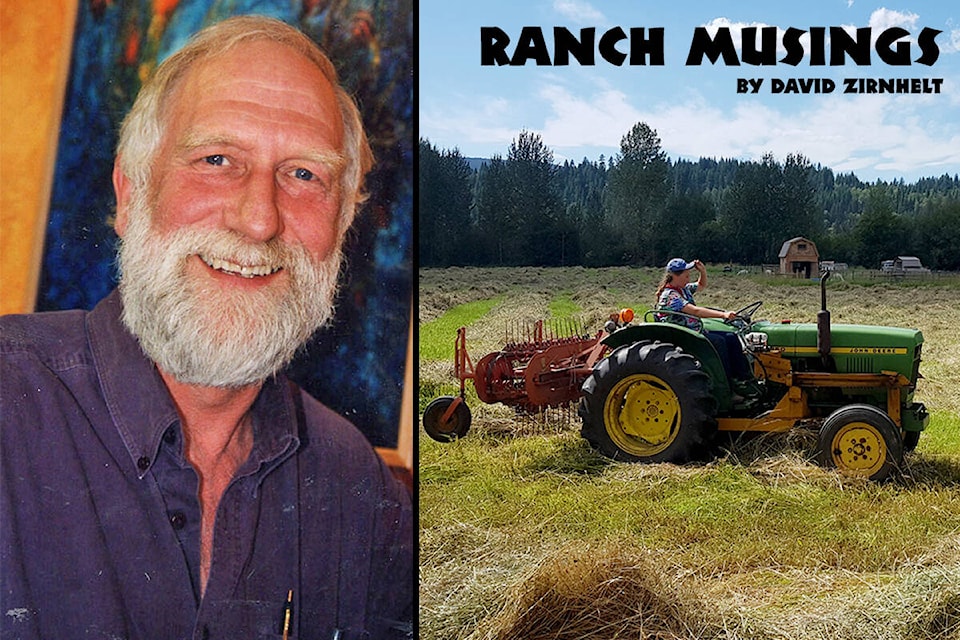Facebook friends of members of our family will have seen a picture of drenched cowboys who had just caught an abandoned calf in a spring pasture.
In a previous article in recent years, I described the challenge of trailing a calf with grandchildren who wanted to ”help” catch a calf for medicating. Usually, they want to try their hand at roping as that has some magic for young and older cowfolks alike.
This story begins with a short cattle drive from early spring pasture to late spring pasture. Because some calves are young and are taught to stay where their moms place them, there are always a few who don’t seem to get mothered up for making the trip.
Two cows came back to find their “lost” calves since we leave gates open. Or if time passes gates get closed and we monitor to see if a mother is trying to get back to where she left her calf and we will open the gates.
One cow came back to find a calf the day of the move and rejoined the herd.
The second cow came back later that day and I found her nursing the calf she left behind. But there was another whose mother we could not identify. It stayed behind when the second cow returned to the herd.
With lots of predatory wildlife around (bears, cougars, wolves) we kept trying to find the lonesome calf. It was usually within a hundred yards of where the mother had parked it.
However, it was not easily caught and we don’t always have a horse with us.
We decided to try to catch it on foot. That was not to be.
Twice a grandchild and I tried to get close enough to get a rope on it. We were eluded for several hours. On one occasion we were able to almost corner it in the lake near a fence line.
My granddaughter was in hot pursuit as I encouraged her to chase it into the lake and catch it.
She and the calf disappeared in the thick brush on the flooded shoreline in two feet of water.
After getting stuck in the mud, the calf got away and headed back to shore where I was waiting –if you call walking on a mat of prone willows trying to stay out of the mud “waiting.” Flashing through my mind were the stories told about the Indigenous people from Lake Sumas who could get away from enemies by walking on the tall grass growing at the lake shore.
The calf came close and I was about to leap on it; but being more nimble than I, it got away. Thinking it would soon be more tired than we were, we thought we might still catch it! Apparently, not having milk for two days did not weaken sufficiently.
Defeated, I sent out an email to the family, some of whom often practice roping in a ranch arena. I said they could do the real thing under bush range conditions if they wouldn’t mind.
They came to the rescue and two on horseback with ropes set out to find it. Two hours into a heavy rainstorm, they found it by looking under every dry Spruce, finding it where it had been hanging out.
By chasing it onto a road they were able to get a shot at it with a lariat. It was thankfully taken to where the herd was grazing for a reunion with its mother. At this point we are hoping none of our efforts were in vain…,
“Settler” culture has a parable of the lost sheep:
The shepherd leaves the 99 others and searches high and low for the lost sheep. Jesus stresses that when the shepherd finds the lost sheep he rejoices over it more than the 99 who did not go astray. This is how God will rejoice when a sinner returns to Him.
A calf is worth about a thousand dollars when sold, but in addition to this financial motive, it is more that we would not want to leave the calf to be preyed upon.
We are secular ranchers, not particularly ones that follow biblical instructions to the letter. One would hope we all follow universal good stewardship of the land and animals under our care!
David Zirnhelt is a rancher and member of the Cariboo Cattlemen’s Association. He is also chair of the Advisory Committee for the Applied Sustainable Ranching Program at TRU.
